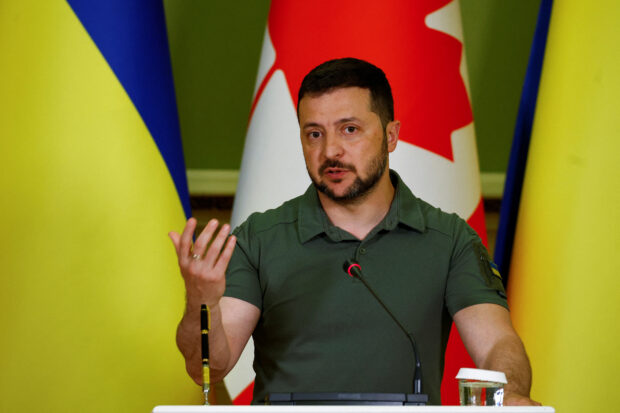Zelensky says counteroffensive actions ‘taking place’ in Ukraine

Ukraine’s President Volodymyr Zelenskiy speaks during a joint press conference with Canadian Prime Minister Justin Trudeau, amid Russia’s attack on Ukraine, in Kyiv, Ukraine June 10, 2023. REUTERS
KYIV — President Volodymyr Zelensky acknowledged on Saturday that his military was engaged in “counter-offensive and defensive operations” a day after Kremlin leader Vladimir Putin said Kyiv’s long-vaunted drive to retake territory was well under way.
But the Ukrainian leader disclosed no details, telling reporters to pass on to Putin that his generals were optimistic.
Sporting his trademark khaki fatigues, Zelensky shrugged at a press conference when asked about Putin’s comments on Friday that Kyiv had begun its counter-offensive but made no progress.
“Counter-offensive and defensive actions are taking place in Ukraine, but I will not say in detail what stage they are at,” Zelensky said, listing Ukraine’s top military brass by name.
“They (the generals) are all in a positive mood. Pass that on to Putin,” he said with a smile, standing alongside visiting Canadian Prime Minister Justin Trudeau.
Article continues after this advertisementHe said Putin’s comments on the counter-offensive were “interesting…It is important that Russia always feels this: That they do not have long left, in my opinion.”
Article continues after this advertisementRussia’s Defense Ministry on Saturday said Ukrainian forces had in the past 24 hours made “unsuccessful” attempts to attack in the southern Donetsk and Zaporizhzhia regions — two areas subject to heavy fighting.
The ministry also mentioned Bakhmut, the eastern town Moscow says it captured last month after 10 months of fierce battles.
Reuters was not able to independently verify the situation on the battlefield.
In his nightly video address, Zelenskiy again provided few details while urging troops to keep fighting.
“Thank you to all those who holds their positions and those who advance,” he said, citing the eastern and southern fronts, where fighting is heaviest.
Ukraine’s general staff said its forces had repelled enemy attacks around Bakhmut and the long besieged town of Maryinka. Russian forces, it said, “continue to suffer heavy losses which they are trying to conceal”.
General Oleksander Syrskyi, commander of ground forces who is in operational control of the counteroffensive, posted a picture on social media of an explosion that he said was a group of Russian soldiers being destroyed near Bakhmut.
Ukrainian military spokesman Serhiy Cherevatyi reported new gains near Bakhmut.
“We’re trying…to conduct strikes on the enemy, we are counter-attacking. We’ve managed to advance up to 1,400 meters (0.87 mile) on various sections of the front,” Cherevatyi said.
Ukraine has said for months it plans a major counter-offensive. But it had denied the main operation has begun.
With scant independent reporting from the front lines, it has been difficult to assess the state of the fighting.
Britain’s Ministry of Defense said Ukraine had conducted “significant” operations in several eastern and southern parts in the last 48 hours, with Russian defenses breached in places.
Some progress–British ministry
“In some areas, Ukrainian forces have likely made good progress and penetrated the first line of Russian defenses. In others, Ukrainian progress has been slower,” it said, also characterizing the Russian military’s performance as mixed.
“Some (Russian) units are likely conducting credible maneuver defense operations while others have pulled back in some disorder, amid increased reports of Russian casualties as they withdraw through their own minefields.”
Ukraine’s counter-offensive is expected to use thousands of troops that have been trained and equipped by the West, but Russia has built huge fortifications in occupied territory to prepare, while Kyiv also lacks air supremacy.
The south is seen as a key strategic priority for a Ukrainian push that could aim to recapture Europe’s biggest nuclear plant and cut the Russian land bridge to the occupied Black Sea peninsula of Crimea, dividing Russian forces.
Ukrainian military analyst Oleksiy Hetman told NV Radio the events of recent days were only initial steps.
“What is happening now could be called ‘reconnaissance in battle’ – the first stage of the offensive,” Hetman said. “It was impossible to make progress in depth. The goal was to check the enemy’s defenses. Let’s wait a few days and see.”